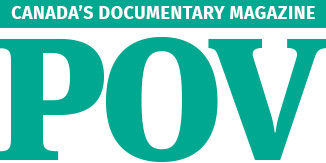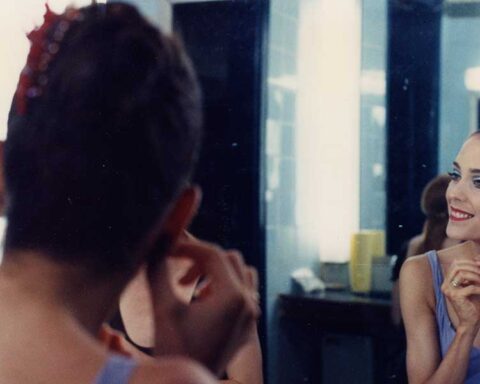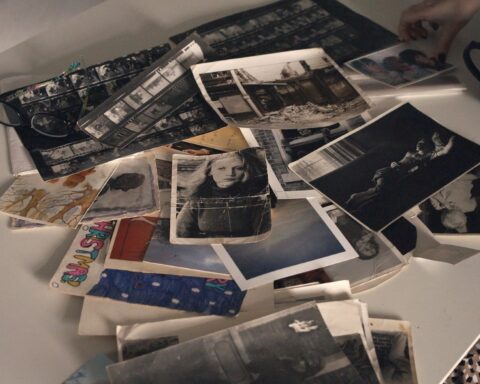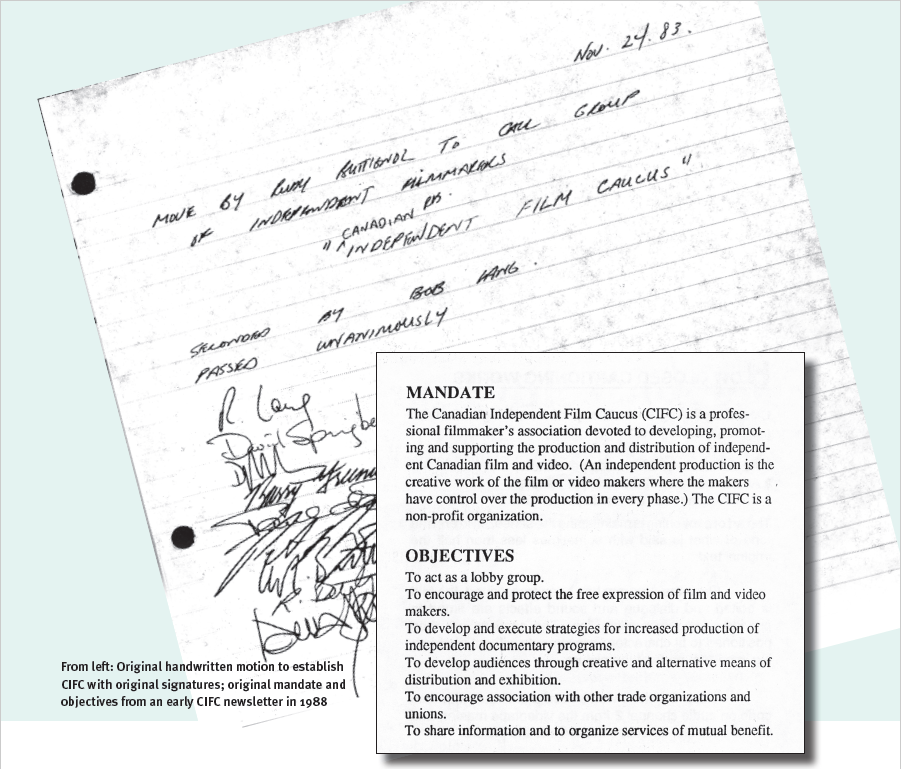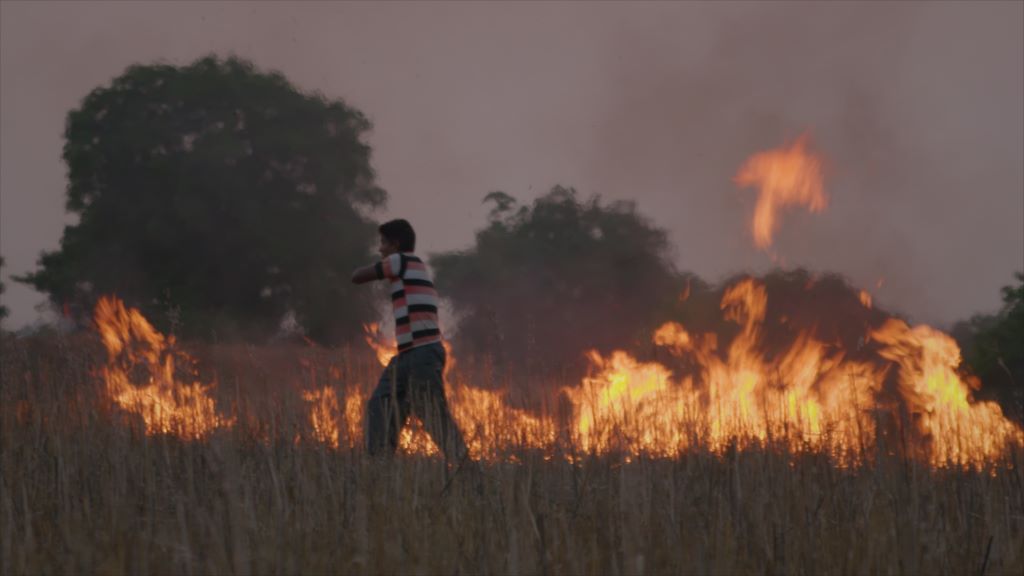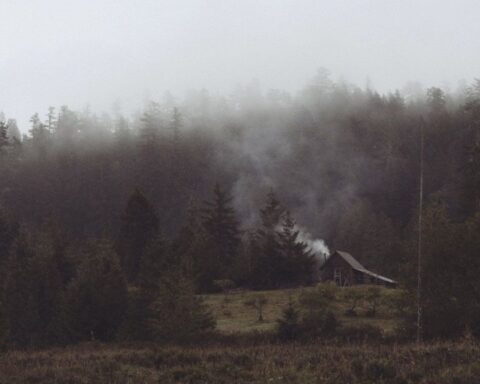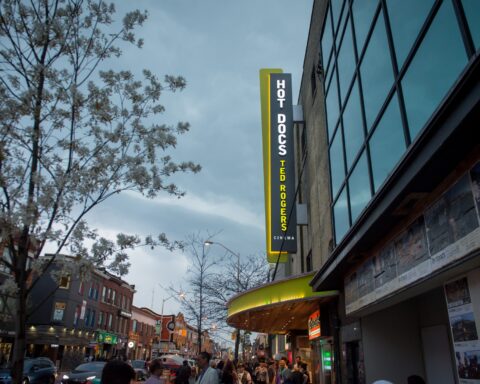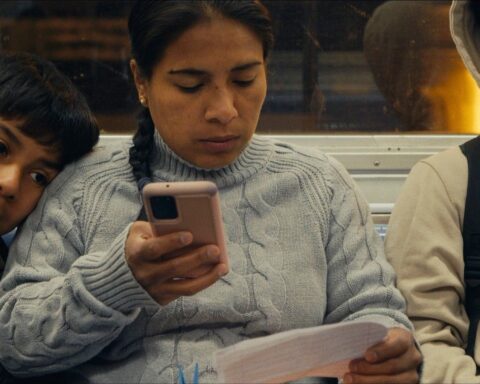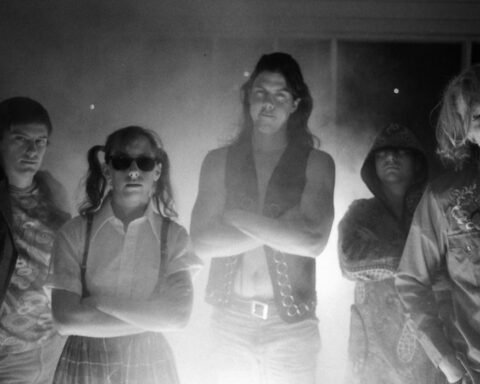It’s another great year for docs! After the POV team more or less agreed on the best documentaries of the year in 2022, we diverge somewhat in our assessments for the year’s best. In part, the variation has lots to do with a shifting (and concerning) landscape for docs: some of the best non-fiction films of 2023 didn’t secure distribution. Readers won’t find them on a streamer and, unless one was fortunate enough to catch a festival screening, one might not have had a chance to see it. Let’s hope that including them alongside frontrunners in an open Oscar race helps them find a home. We hope that our picks for the best documentaries of 2023 inspire some holiday viewing.
The Best Documentaries of 2023
Note: POV included the Canadian docs To Kill a Tiger and Rojek in our list of 2022’s best docs. We’re beyond thrilled that they’re reaching more audiences this year.
Pat Mullen’s Top Ten
1. Milisuthando (dir. Milisuthando Bongela)
Nothing is more exciting than encountering a new voice that radically shakes up an art form. Milisuthando Bongela’s feature debut offers exactly the kind of discovery one hopes to see at a festival. The film’s expansive scope, rich personal history, and innovative approach to form immediately marked it as the standout film of this year’s Sundance Film Festival. The film is even better on the big screen—a truly cinematic work of art—and proved the best of the fest when I caught it on the big screen at Hot Docs. Milisuthando asks provocative and vital questions about the social construction of racism and the ways in which it is so deeply entrenched in our daily lives. By examining institutional racism, the roots of apartheid in South Africa, and the ways in which people normalize caste systems into their daily habits, the film interrogates the path forward to common ground. Moreover, as Bongela delivers her essay in a fiercely poetic tongue, Milisuthando reminds viewers never to lose sight of the experiences that shape one’s voice or worldview. Could some distributor please buy this movie?
2. 20 Days in Mariupol (dir. Mstyslav Chernov)
Few films capture wars from the front lines quite like 20 Days in Mariupol does. This eye-opening, if emotionally exhausting, film goes behind the soundbites to tell a fuller story about the Russian invasion of Ukraine and the violence committed against Ukrainians of all stripes. Moreover, Chernov uses his documentary’s point of view to challenge the fake news and misinformation campaigns that create a war of their own. (Watch it in full here.)
3. Swan Song (dir. Chelsea McMullan)
Who expects a ballet documentary to be an edge-of-your-seat thrill ride? This backstage portrait of Karen Kain’s farewell to the stage captures the legacy and fearlessness of one of Canada’s greatest performers. The doc also confirms Chelsea McMullan as one of Canada’s freshest artists behind the camera for their immersive portrait that defies conventions of celebrity biography. Kain’s the draw, but the next generation of dancers steal the show.
4. De Humani Corporis Fabrica (dir. Véréna Paravel, Lucien Castaing-Taylor)
The Sensory Ethnography Lab folks redefine gutsy filmmaking with this bravura experimental work. De Humani Corporis Fabrica takes audiences inside the human body to look at the natural wonder in which we live. Using tiny cameras engineered for the film, Fabrica explores slimy entrails, squishy insides, and bloody orifices, yet it somehow manages to be the duo’s most accessible film to date. It’s a wonder when a film provides a perspective on the world that one couldn’t see otherwise. (Watch it on MUBI.)
5. Pictures of Ghosts (dir. Kleber Mendonça Filho)
Bacurau director Kleber Mendonça Filho returns to the scene of the crime that housed films like Neighbouring Sounds: his apartment. Mendonça Filho delivers a personal exploration of cinema, his hometown of Recife, and history that haunts film images by happenstance. Playfully fusing elements of style and form, Mendonça Filho traces his path as a filmmaker and the ways in which his story is intimately linked to the corners of the city that inform, inspire, and fuel his work. (Coming soon to theatres.)
6. The Disappearance of Shere Hite (dir. Nicole Newnham)
The Hite Report predates my generation, so I really appreciate this resonate portrait of gender equality. Newnham illuminates a life, story, and work that I’d heard about only tangentially or encountered briefly in school. As she explores Shere Hite’s groundbreaking and controversial research into the sex lives of men and women, Newnham offers a refreshing “new edition” in which Hite’s work—and disappearance—echo in many stories today.
7. The Eternal Memory (dir. Maite Alberdi)
This Sundance Grand Jury Prize winner is disarming in its simplicity. The film is a deeply moving portrait of actor and politician Paulina Urrutia and her husband, journalist and writer Augusto Góngora. Maite Alberdi delicately observes this tender relationship as Paulina cares for Augusto as his mind slips away due to Alzheimer’s. Their love endures, though, which makes this film such a bittersweet portrait love story.
8. Menus-Plaisirs – Les Troigros (dir. Frederick Wiseman)
Pack a lunch while tucking in with Menus-Plaisirs. Not only is Wiseman’s latest observational opus four hours long, it takes audiences inside a three-Michelin-starred restaurant to capture the creation and enjoyment of culinary art. While the running time is intimidating, it’s hard to find an ounce of fat in the film that isn’t sizzling on screen. Every film deserves a 20-minute cheese course. Wiseman puts the “chef” in chef d’oeuvre. (In select theatres.)
9. Name Me Lawand (dir. Edward Lovelace)
Name Me Lawand is a groundbreaking work when it comes to representing stories of disability on screen. The film uses an innovative and layered sound design to convey a sense of deafness as it shares the story of Lawand, a young Iraqi refugee in the UK learning British Sign Language while his family fights to stay in the country. The film offers a textbook example for accessible filmmaking, while uses said accessible elements to elevate the artistic pedigree.
10. Someone Lives Here (dir. Zack Russell)
It’s hard to believe that the deeply empathetic Someone Lives Here is Zack Russell’s first feature. Canada’s documentary tradition is in fine form here with this portrait of Toronto’s housing crisis and the efforts of carpenter/activist Khaleel Seivwright The film gathers experiences from unhoused people as offscreen commentators, who, in turn, underscore the human element that gets lost amid the bureaucratic indifference that Seivwright encounters. It’s no wonder that Toronto is in such a sorry state, but the film offers some hope through Seivwright’s story.
Save it for next year: Mountain Queen: The Summits of Lakhpa Sherpa – I realise it’s inconsistent to defer listing this film when a doc without distribution tops my picks, but Lucy Walker’s spectacular Mountain Queen screened at TIFF as a work in progress. I don’t feel that it’s right to include a film without seeing the ‘final final’ version before Netflix releases it to audiences. The bar for 2024 is very, very high—like, Everest high.
Honourable mentions: American Symphony; Batata; Beyond Utopia; Confessions of a Good Samaritan; Every Body; Feet in Water, Head on Fire; Four Daughters; The Human Surge 3; Kokomo City; The Mother of All Lies; Still; Taylor Swift: The Eras Tour; Youth (Spring).
Marc Glassman’s Top Ten
1. The Mother of All Lies (dir. Asmae el Moudir)
Set mainly in a street in Casablanca recreated in a scale model by director Asma el Moudir’s father Mohamed, The Mother of All Lies is one of the most outrageous and devastating documentaries ever made. Growing up, the young Asmae was dominated by her intense, abrupt grandmother Zahra, who controlled the whole family. In working through her traumatic life with friends and relatives, Asmae’s documentary slides from personal reminisces to a central episode in Morocco’s past, the harsh repression by the government when confronted by the 1981 Bread Riots. Many people died, including a 12-year-old Casablanca girl, Fatima. Nothing happened to Asmae’s family because Zahra refused to let any of them out to participate in the protests. She likely saved their lives, which served to justify her continual authoritative behaviour over the years. Asmae’s community’s recollections of the Riots and Morocco’s autocratic past help in understanding the film’s most audacious artistic intervention, the creation of marionettes who play out their lives for the director. It is period recreation as theatre, with the puppets being the Moroccan people who were dominated by a willful aristocracy. The Mother of All Lies is a deeply moving film: truly the personal is the political in this brilliant documentary hybrid. (Coming soon to theatres.)
2. Menus-Plaisirs Les Troisgros (dir. Frederick Wiseman)
Documentary master Frederick Wiseman has crafted a masterpiece, likely the finest film about food ever made. Wiseman concentrates on the Troisgros family, veteran chefs for several generations who have a three-star Michelin restaurant and hotel in the countryside near Roanne in the French Alps region. It’s gorgeous terrain, which Wiseman explores with chef Michel, his heir Cesar and younger son Leo, all of whom spend time talking to their suppliers—wine growers, livestock herders, and produce farmers. Along with cheesemakers, they are like the Troisgros restaurateurs, totally invested in what they’re doing to the point of near-obsession. The film is organized around dialogues in which earthy wisdom is conveyed through fascinating discussions on such topics how the birth cycles of goats, the proper soil for growing grapes and the length of time for cheese to properly reach its peak flavourful period. Quality time is spent in detail showing the preparation and serving of the great meals at the restaurant. Like the filmmaker, the Troisgros family are brilliant professionals, dedicated to the artistry of what they are making. Quietly, Menus-Plaisirs Les Troisgros is an ecological film, enmeshed in the wonders of slow living. In the sped-up reality of these times, it offers a vision of a better way of life.
3. Anselm (dir. Wim Wenders)
That Anselm Kiefer is in the top echelon of contemporary artists is incontestable; whether he ranks as number one in anyone’s rankings is purely a matter of taste. (He’s my favourite for reasons that may prove obvious as you read this piece.) Kiefer’s paintings and sculptures are monumental and confrontational in the manner of many extraordinary German artists and yet his philosophy is profoundly anti-Fascist, creating a tension that adds complexity to whatever he makes. Wim Wenders, like Kiefer, born in Germany in 1945, has wrestled with the past in such works Wings of Desire and Paris, Texas, and has his own problematic relationship with Germany. (Both have spent years making work outside of the country.) The pairing of the two for the film Anselm, Wenders as documentarian and Kiefer as subject, seems inevitable especially as they are such good friends that Wenders cast the painter’s son, Daniel, in faux newsreel scenes of him as a young artist and the director’s grand-nephew Anton Wenders as Kiefer as a child.
Anselm is another successful foray by Wenders into 3-D, the first being his documentary on the revolutionary choreographer Pina Bausch. Like Bausch, Kiefer’s complex work is textured and, more than most artists, it is highly layered with materials like straw and ash and metals being integral elements along with paint in his massive landscapes. Several scenes show Kiefer, dressed in his characteristic black shirt and pants, burning and breaking painterly elements, including canvases, to make the work better. We see him and his assistants in huge warehouses engaged in “deconstructive” practices, all acting with solemnity, knowing that they are creating monumental pieces that carry the weight of art and history.
Kiefer’s characteristic paintings are huge vistas, which use a dark palette apart from huge swaths of yellow, to depict a universe gone awry. To call them beautiful seems bizarre and yet they are so overwhelmingly painted that they are gorgeous to view. Wenders, judiciously using 3 and 2-D, renders the works brilliantly. Nor does he ignore his role as a proper documentary filmmaker. While Wenders gives us very little about Kiefer’s private life, the audience does find out about how his philosophy of art making was formed.
The major names in the formation of Kiefer’s cosmology are Paul Celan, Martin Heidegger and his mentor, Joseph Beuys. All are heavily influenced by their relationship to the Nazis. Celan, the brilliant poet, was Jewish and although he survived in a Nazi labour camp, his parents perished in the Holocaust. His poem Todesfuge (Death Fugue) was inspired by the concentration camps and is extraordinary linguistically; it has been made into songs and performance pieces. Heidegger, the eminent philosopher whose contributions to hermeneutics, phenomenology and existentialism are extraordinary, infamously joined the Nazi Party although he had an affair with one of his students, Hannah Arendt, the Jewish philosopher creator of the term “the banality of evil.” Beuys had fought for the Nazis during World War Two but reinvented himself as a teacher and performance artist, who believed in the role of art as a political and humanistic tool for the betterment of the world.
Kiefer’s art is that of someone who has confronted the evils of the past and wants to expose them to the world. His work is replete with the rich heritage of Norse and Teutonic mythology and a fierce knowledge of Greek tragedy. Kiefer’s sculptures often have the shape and density of huge books, filled with the texts of the past greats. They’re often placed on shelves that seem fit for libraries or archives of giants from an ancient civilization. Everything is huge, offering the sense of a romantic time of great gods now lost to us.
Wenders conveys this all to us in precise images and fluid camerawork. He is less successful in giving us an interpretation of Kiefer as a man-child still fighting against all odds to reveal his truths to the world. Perhaps his love for the great painter makes it hard for him to avoid a grandiloquent finale to the film. Nevertheless, Anselm is a film worthy of the man and an extraordinary portrait of a great artist. (Now in theatres.)
4. Four Daughters (dir. Kaouther Ben Hania)
Like The Mother of All Lies, Four Daughters is a documentary hybrid by a North African Muslim woman, which has garnered international acclaim. Both are their country’s nominees for the Academy Award for Best International Feature Film: Morocco for Asmae el Moudir’s film and Tunisia for this work by Kaouther Ben Hania. And the films were the co-winners of the prestigious L’Œil d’or, le prix du documentaire at Cannes (The Golden Eye, The Documentary Prize at Cannes) in 2023.
Four Daughters mixes the personal and the political as does The Mother of All Lies, but it’s a completely contemporary tale. Ben Hania’s film concentrates on the family of Olfa, who are hugely influenced by the Arab Spring and the subsequent rise of ISIS. A fierce woman of limited financial means, Olfa had been trying to raise four daughters by herself after her relationship with her husband fell apart.
As the film begins, we discover that two of the daughters have been “devoured by the wolf,” while the other two are squabbling but still at home. Olfa’s story, which had become national news in Tunisia, resonated with Ben Hania who decided to make it into a meta-documentary-narrative film.
In order to show how the winds of change have affected one family, Ben Hania hired actresses to play the two missing daughters as well as Olfa, because, she explains, some scenes will be too emotional for a non-actor to play properly. Of course, Olfa is in the film—she often dominates it—as are the two younger daughters, who have to act with women playing their sisters. The results are fascinating as varying ideas of religious behaviour, romantic role playing, and familial tensions are performed for the camera.
We realize that Olfa was hardly a great mother and that the missing older girls had reasons for wanting to leave their home apart from a gradual interest in ISIS. By focusing on one complicated family dynamic, Ben Hania is able to convey how quickly Tunisian society changed from the time of the Spring to the chaotic present. We also discover that the older daughters aren’t dead, but their fates are inextricably bound to the radical shifts in Arab society at the present. Four Daughters is a film that tries to do too much but it does succeed in giving us a profound sense of what it’s like to try to negotiate a life in a shifting, violent but vibrant society in North Africa. (Opens in theatres in January.)
5. Batata (dir. Noura Kevorkian)
Noura Kevorkian, this year’s DOC Vanguard artist, has made an intense humanistic story about Maria, a resourceful middle-aged woman, who is keeping her Syrian family together emotionally and physically as the world falls apart around them. Farmers struggling to succeed in Lebanon as the film begins, Maria and her family go through far worse as the war deepens in Syria and spills over into Lebanon. Kevorkian sticks with Maria as she finds a home for them in displaced people camps. Kevorkian’s eye for human interaction, and particularly between children, is remarkable. The sense of life in the camps is vivid—startlingly real and evocative. While everyone survives, the men have little work to do, and the children aren’t getting proper education.
Batata is an extraordinary film because Kevorkian stuck with it, even as the human drama changed, and the politics of the situation became more dire and complex. Part of the respect one has for the film is an admiration for Kevorkian’s doggedness in telling the story of Maria and her family. The rest is one’s appreciation of a film that records “normal” events—weddings, funerals, dinners—even during immense civil strife.
6. The Eternal Memory (dir. Maite Alberdi)
The Grand Jury Prize winner in World Cinema at Sundance earlier this year, The Eternal Memory is an intensely moving tale of the effects of Alzheimer’s on a loving, artistic Chilean couple. Augusto Góngora was a courageous journalist who opposed the dictatorial regime of Pinochet and then was a beloved arts journalist when democracy returned, until the disease began to affect his mind, causing him to retire in 2014. His wife Paulina “Pauli” Urrutia, an actress, who served as the Minister of Culture and the Arts from 2006 to 2010, is shown taking care of him as he fades away from the dynamic person he had been before Alzheimer’s hit him.
Director Maite Alberdi, who made the funny, wise doc The Mole Agent, is excellent at working with older people and has a deft touch, which allows her to characterize people with great perception. Through judicious use of archival footage—this couple is famous—she’s able to evoke the dynamic, perceptive person that Góngora was before the disease struck. Perhaps most devastating is that Góngora, like most intellectuals and artists in Chile, was especially concerned about memory: how the Socialist regime of Allende had been wiped out of people’s minds and the deaths of tens of thousands leftist activists under Pinochet went unreported as simply being “disappeared.” It’s the ultimate irony that Góngora ended up suffering from the national disease as his memory went away. This political resonance adds depth to a tale of love that endured despite everything, despite COVID, despite Alzheimer’s.
7. Feet in Water, Head on Fire (dir. Terra Long)
Feet in Water, Head on Fire offers a deliberately imperfect rendering of the fractured realities of California’s Coachella Valley. It is a land of contradictions, replete with mystery, toxicity, folk tales, and terrifying beauty. Set in the desert, the valley is famous for its date-palm tree farms amid a growing network of golfing communities and residences for America’s aging wealthy. The farmers, mainly of Mexican origin, and golfers, overwhelmingly white and privileged, co-exist with the Cahuilla Indigenous people, who are exploring their own roots while gradually growing in influence. Barely visible to each other, they all inhabit a land dominated by the San Andreas Fault, where two tectonic plates are forcing deeply buried water to the surface and forming oases until the inevitable disaster occurs, when powerful earthquakes will devastate the region.
Feet in Water, Head on Fire is part of a new wave of filmmaking that is breaking barriers in documentary cinema. The approach of directors like Jacquelyn Mills and Lina Rodriguez is equally emotional, instinctual, and poetic. It may be unsurprising that all three are women, since today’s risk takers so often are. Terra Long has made a documentary that resists the standard form and prospers on its own terms, offering insights into the disparate communities that make up Coachella. She expects us to make the connections that keep prosperous whites, working class Mexican-Americans and long-standing Indigenous people living separately but somehow together in an odd, terrifying and poetic area of California.

8. 20 Days in Mariupol (dir. Mstyslav Chernov)
The war in Ukraine has been going way too long. It’s a war of attrition, being fought with old-style weapons—tanks and bombs and missiles and guns. People are dying slowly in plain view, like they did in World War II and Korean War films. The footage we see in Mstyslav Chernov’s 20 Days in Mariupol is shockingly contemporary, but it also has the resonance of classic war photos and docs from the past. That’s no surprise given that Chernov is a Pulitzer and George Polk award-winning photographer and his images, deeply humanist and courageously shot, are combined with those collected from Frontline and the Associated Press. We see the best of the worst in this film—the atrocities and terror and deep humanity, which emerges when people are being attacked with no hint of mercy. Chernov has made a film that is essential viewing.
9. Swan Song (dir. Chelsea McMullan)
Women, and men, honing their bodies and minds for the art of dance is the subject of Chelsea McMullan’s latest performance-art documentary. Swan Song documents the creation of a newly choreographed version of the beloved romantic Swan Lake, overseen by the internationally acclaimed Karen Kain in 2022 during her final year as the artistic director at the National Ballet of Canada. Kain’s main suggestion, to show the dancers’ legs without tights, emphasizes their humanity as performers and is a wonderful contemporary touch. Mirroring that personal notion, McMullan spends a good part of the film on Jurgita Dronina the principal dancer, and Shaelynn Estrada, an up-and-comer, showing personal issues—physical and emotional—which affect their work. Kain famously interpreted Swan Lake as the principal dancer in 1971, so McMullan’s intimate documentary brings the grand ballet and the career of one of its finest performers to an appropriate close.
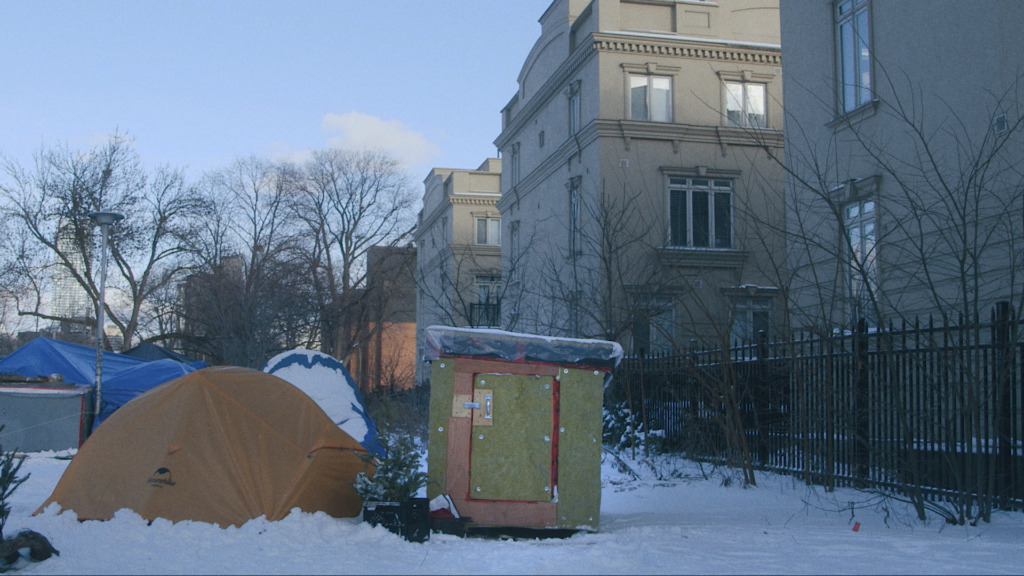
10. Someone Lives Here (dir. Zack Russell)
The fate of the homeless has become a huge issue in Toronto over the past decade as the cost of shelters keeps on rising while more people are finding themselves without proper wages. Zack Russell’s film addresses that situation during a harsh COVID winter when the stakes for those without housing were at their highest. Most well-made docs feature a character with whom audiences can identify and this film is no exception. Russell’s film is created around Khaleel Seivright, a funny down-to-earth carpenter who decides to make plain insulated wooden structures to house the homeless in parks throughout the city’s downtown core. Instead of receiving commendations from the government, the city of Toronto actively fought Khaleel since he hadn’t worked with them, getting permits for his act of civic kindness. Russell documents Khaleel’s legal struggles while the voice of Taka, someone sleeping in one of his shelters, sardonically expresses her relief and gratitude for staying alive during a terrible time in her life. Russell has made a film that appears to be simple, about a decent man being harassed for trying to help people, but once you get into questions of civil politics and community vs. individual rights, the complexity of his story becomes apparent. Someone Lives Here documents civil disobedience, on Khaleel’s part, and the right of the homeless to have choices in where they can live, versus the hidebound conservatism of too many Toronto administrators. It’s a time capsule, a document of how we live now, while indicating how things could improve.
Honourable Mentions: The Disappearance of Shere Hite, Kokomo City, Still, De Humani Corporis Fabrica
These four “mentions” are as good as the rest of my top ten docs. I urge you to see all of them—and others that didn’t make my list or Pat’s. You can’t go wrong viewing docs. Please see one from today
